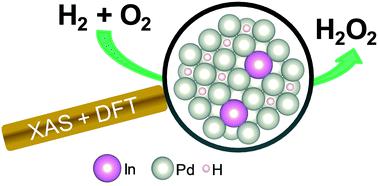当前位置:
X-MOL 学术
›
Catal. Sci. Technol.
›
论文详情
Our official English website, www.x-mol.net, welcomes your
feedback! (Note: you will need to create a separate account there.)
Dynamic structural changes of supported Pd, PdSn, and PdIn nanoparticles during continuous flow high pressure direct H2O2 synthesis
Catalysis Science & Technology ( IF 4.4 ) Pub Date : 2020-06-22 , DOI: 10.1039/d0cy00553c Dmitry E. Doronkin 1, 2, 3, 4, 5 , Sheng Wang 1, 2, 3, 4, 6 , Dmitry I. Sharapa 1, 2, 3, 4 , Benedikt J. Deschner 2, 3, 4, 7 , Thomas L. Sheppard 1, 2, 3, 4, 5 , Anna Zimina 1, 2, 3, 4, 5 , Felix Studt 1, 2, 3, 4, 5 , Roland Dittmeyer 2, 3, 4, 7 , Silke Behrens 1, 2, 3, 4, 6 , Jan-Dierk Grunwaldt 1, 2, 3, 4, 5
Catalysis Science & Technology ( IF 4.4 ) Pub Date : 2020-06-22 , DOI: 10.1039/d0cy00553c Dmitry E. Doronkin 1, 2, 3, 4, 5 , Sheng Wang 1, 2, 3, 4, 6 , Dmitry I. Sharapa 1, 2, 3, 4 , Benedikt J. Deschner 2, 3, 4, 7 , Thomas L. Sheppard 1, 2, 3, 4, 5 , Anna Zimina 1, 2, 3, 4, 5 , Felix Studt 1, 2, 3, 4, 5 , Roland Dittmeyer 2, 3, 4, 7 , Silke Behrens 1, 2, 3, 4, 6 , Jan-Dierk Grunwaldt 1, 2, 3, 4, 5
Affiliation

|
The direct synthesis of hydrogen peroxide over TiO2-supported mono- and bimetallic Pd, PdSn, and PdIn nanoparticles (NPs) was performed in a continuous plug-flow reactor at 80 bar in ethanol with H2 : O2 ratios varied from 10 : 1 to 1 : 10. At the same time the catalysts were monitored by operando X-ray absorption spectroscopy (XAS). The setup optimized for XAS allowed productivities that are among the highest reported up to now. A rate of up to 580 mmolH2O2 gcat−1 h−1 and a H2O2 concentration of 80 mmol l−1 were obtained which were only limited by the supply of reactants. During H2O2 synthesis, the studied NPs revealed a face centered cubic (fcc) Pd(Sn/In) metal (alloy) structure at H2 : O2 ratios equal to or smaller than 1 and the corresponding β-hydride structure at H2 : O2 > 1. Under all conditions, additional SnO2/In2O3 species were observed for the bimetallic catalysts. XAS supported by DFT calculations showed that alloying Pd with In or Sn limited the H2 uptake capacity and the corresponding lattice expansion of the bimetallic NPs. Different catalysts performed best at different H2 : O2 ratios. All catalysts were stable at H2 : O2 > 1. Significant leaching of the active Pd and PdIn species could be observed for H2 : O2 ≤ 1 (quantified by XAS), while PdSn was relatively stable under these conditions. The higher stability of PdSn NPs is proposed to be due to a SnO2 shell providing strong bonding between the NPs and the titania support.
中文翻译:

连续流动高压直接H2O2合成过程中负载的Pd,PdSn和PdIn纳米粒子的动态结构变化
在TiO 2负载的单金属和双金属Pd,PdSn和PdIn纳米颗粒(NPs)上直接过氧化氢的直接合成是在连续活塞流反应器中在80 bar的乙醇中进行的,H 2 :O 2的比率为10:10。图1至1:10。同时,通过操作X射线吸收光谱法(XAS)监测催化剂。针对XAS进行了优化的设置可以使生产率达到目前为止所报告的最高水平。最高580 mmol H 2 O 2 g cat -1 h -1的速率和H 2 O 2浓度为80 mmol l -1获得仅受反应物供应限制的产物。在H 2 O 2合成过程中,所研究的NPs在H 2 :O 2比等于或小于1的情况下显示出面心立方(fcc)Pd(Sn / In)金属(合金)结构,而在H 2:O 2处对应的β-氢化物结构H 2 :O 2 > 1.在所有条件下,双金属催化剂均观察到其他SnO 2 / In 2 O 3物质。DFT计算支持的XAS显示,Pd与In或Sn合金化会限制H 2吸收能力和双金属NP的相应晶格扩展。不同的催化剂在不同的H 2 :O 2比下表现最佳。所有催化剂均稳定在ħ 2 :o 2 > 1.重大用于h可以观察到活性Pd和PDIN物种的浸出2 :o 2 ≤1(XAS定量),而PDSN在这些条件下相对稳定。提出PdSn NP更高的稳定性是由于SnO 2壳在NP和二氧化钛载体之间提供了牢固的结合。
更新日期:2020-07-21
中文翻译:

连续流动高压直接H2O2合成过程中负载的Pd,PdSn和PdIn纳米粒子的动态结构变化
在TiO 2负载的单金属和双金属Pd,PdSn和PdIn纳米颗粒(NPs)上直接过氧化氢的直接合成是在连续活塞流反应器中在80 bar的乙醇中进行的,H 2 :O 2的比率为10:10。图1至1:10。同时,通过操作X射线吸收光谱法(XAS)监测催化剂。针对XAS进行了优化的设置可以使生产率达到目前为止所报告的最高水平。最高580 mmol H 2 O 2 g cat -1 h -1的速率和H 2 O 2浓度为80 mmol l -1获得仅受反应物供应限制的产物。在H 2 O 2合成过程中,所研究的NPs在H 2 :O 2比等于或小于1的情况下显示出面心立方(fcc)Pd(Sn / In)金属(合金)结构,而在H 2:O 2处对应的β-氢化物结构H 2 :O 2 > 1.在所有条件下,双金属催化剂均观察到其他SnO 2 / In 2 O 3物质。DFT计算支持的XAS显示,Pd与In或Sn合金化会限制H 2吸收能力和双金属NP的相应晶格扩展。不同的催化剂在不同的H 2 :O 2比下表现最佳。所有催化剂均稳定在ħ 2 :o 2 > 1.重大用于h可以观察到活性Pd和PDIN物种的浸出2 :o 2 ≤1(XAS定量),而PDSN在这些条件下相对稳定。提出PdSn NP更高的稳定性是由于SnO 2壳在NP和二氧化钛载体之间提供了牢固的结合。











































 京公网安备 11010802027423号
京公网安备 11010802027423号